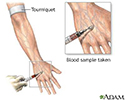Chromium - blood test
Serum chromium
Chromium is a mineral that affects insulin, carbohydrate, fat, and protein levels in the body. This article discusses the test to check the amount of chromium in your blood.
How the Test is Performed
A blood sample is needed. Most of the time blood is drawn from a vein located on the inside of the elbow or the back of the hand.
Drawn from a vein
Venipuncture is the collection of blood from a vein. It is most often done for laboratory testing.

How to Prepare for the Test
You should stop taking mineral supplements and multivitamins for at least several days before the test. Ask your health care provider if there are other medicines you should stop taking before testing. Also, let your provider know if you have recently had contrast agents containing gadolinium or iodine as part of an imaging study. These substances can interfere with testing.
How the Test will Feel
You may feel slight pain or a sting when the needle is inserted. You may also feel some throbbing at the site after the blood is drawn.
Why the Test is Performed
This test may be done to diagnose chromium poisoning or deficiency.
Normal Results
Serum chromium level normally is less than or equal to 1.4 micrograms/milliliter (µg/mL) or 26924.80 nanomoles/L (nmol/L).
Normal value ranges may vary slightly among different laboratories. Talk to your provider about the meaning of your specific test result.
What Abnormal Results Mean
Increased chromium level may result if you are overexposed to the substance. This may happen if you work in the following industries:
- Leather tanning
- Electroplating
- Steel manufacturing
Decreased chromium level only occurs in people who receive all of their nutrition by vein (total parenteral nutrition or TPN) and do not get enough chromium.
Considerations
Test results may be altered if the sample is collected in a metal tube.
References
Kao LW, Rusyniak DE. Chronic poisoning: trace metals and others. In: Goldman L, Schafer AI, eds. Goldman's Cecil Medicine . 25th ed. Philadelphia, PA: Elsevier Saunders; 2016:chap 22.
Mason JB. Vitamins, trace minerals, and other micronutrients. In: Goldman L, Schafer AI, eds. Goldman's Cecil Medicine . 25th ed. Philadelphia, PA: Elsevier Saunders; 2016:chap 218.
National Institutes of Health. Chromium. Dietary Supplement Fact Sheet. ods.od.nih.gov/factsheets/Chromium-HealthProfessional/ Accessed June 23, 2015.
-
Blood test - illustration
Blood is drawn from a vein (venipuncture), usually from the inside of the elbow or the back of the hand. A needle is inserted into the vein, and the blood is collected in an air-tight vial or a syringe. Preparation may vary depending on the specific test.
Blood test
illustration
-
Blood test - illustration
Blood is drawn from a vein (venipuncture), usually from the inside of the elbow or the back of the hand. A needle is inserted into the vein, and the blood is collected in an air-tight vial or a syringe. Preparation may vary depending on the specific test.
Blood test
illustration
-
Diabetes
(Alt. Medicine)
Review Date: 4/30/2015
Reviewed By: Laura J. Martin, MD, MPH, ABIM Board Certified in Internal Medicine and Hospice and Palliative Medicine, Atlanta, GA. Also reviewed by David Zieve, MD, MHA, Isla Ogilvie, PhD, and the A.D.A.M. Editorial team.

